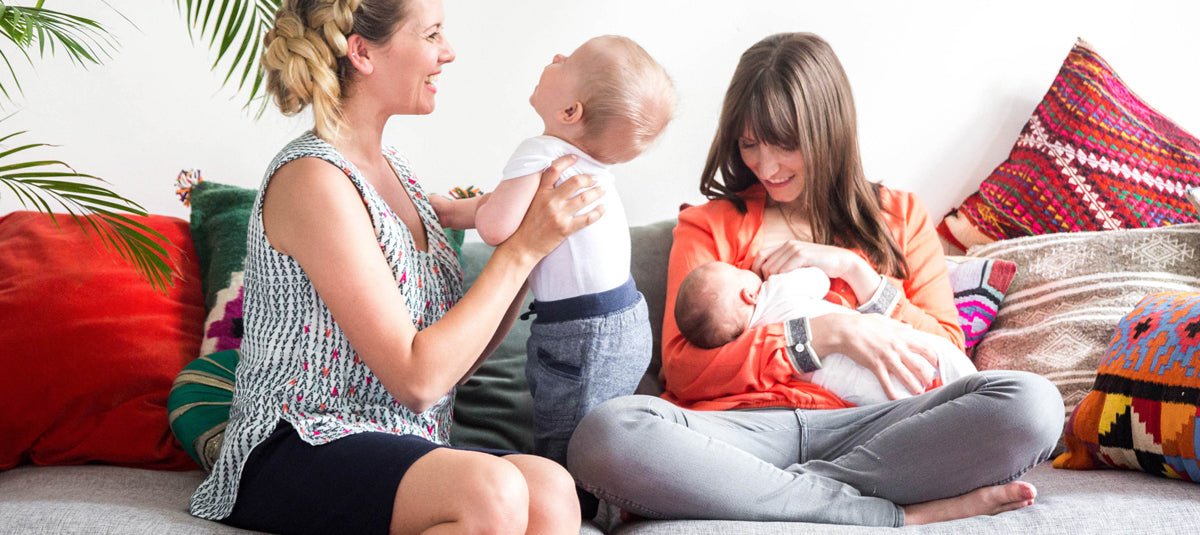
Exercise during pregnancy
Pregnancy is an exciting time! There are the good, easy days and then moments when you are just exhausted... There are many questions that pregnant women ask themselves. One of them is which sports they can do during pregnancy and to what extent? Some women are afraid of being physically active because they don't want to hurt their baby. Other women, however, run 30km while pregnant and then go to kickboxing classes. The answer to this question is, as always - everything in moderation. And because we find the topic so exciting ourselves, we have put together a little exercise inspiration for you: facts and tips on exercising during the first, second and third trimesters, so that you and your baby are doing well.
Before you create an exercise plan for your pregnancy, it's important to first consider how active you were before pregnancy. If you say you're more of a couch potato, now isn't the best time to sign up for an ultramarathon. But if you're one of those women who enjoys running ultramarathons (respect!), you should do a bit more relaxed exercise now. However, that doesn't mean that pregnancy is an excuse for you to just sit around on the couch. Quite the opposite: it's been proven that if you normally do a lot of exercise, it's actually bad for you and your baby to stop exercising altogether. Mentally and physically, it's very important to be as strong and fit as possible for the birth. However, it's very important to discuss everything with your doctor beforehand and always stop immediately if anything hurts or is uncomfortable!
First trimester
In the first trimester, your body begins to adjust to hormonal changes. You're probably familiar with morning sickness, swollen ankles, and a sore back. During this initial phase, it's very important to listen to your body. If you're already ready to exercise, here are a few tips to get you started:
- Warming up and cooling down is always important when exercising. Even more so when you're pregnant. Try stretching a bit. You could even see if you can (still) touch your toes.
- A little exercise, but more often, is enough. A half-hour walk a day is ideal for pregnant women. It improves circulation, builds muscle, and increases oxygen supply. All of this is good for you and your baby!
- If it's hot and the sun is shining brightly, please don't exercise. Instead, we recommend finding a nice shady spot and relaxing with some lemon water—it's truly relaxing!
- "Drink, drink, drink!" takes on a whole new meaning during pregnancy. It's important to stay hydrated at all times. Water is now your new best friend!
During your first trimester, you can perform approximately 50-75% of your normal routine. If you were a runner before, you certainly don't need to give up, unless recommended by your gynecologist, of course. However, you should be cautious. It's better to run on flat terrain, as there's less risk of tripping. And if the ground is icy, use the treadmill at the gym instead.
If you don't normally exercise and think it would be beneficial for you and your baby, head for a pool. The water will support your weight and reduce pressure on your legs and back. Swimming and aqua aerobics are gentle on your joints, and you can't fall in water. At the same time, you'll build your muscles and strengthen your heart—all of which are very important for the day of birth.
However, there are also sports that should only be practiced with caution and after consulting a doctor during the first trimester. These include sports where you might fall, such as horseback riding, hockey, gymnastics, or cycling. Other sports such as kickboxing or judo should be avoided because of the risk of being hit in the stomach.
During the first trimester, you should simply do a more relaxed and calm version of exercise than you did before pregnancy. You have to listen to your body and avoid dangerous exercises.
Second trimester
From week 13 to week 28, the obvious changes in your appearance and perception begin. Other people will notice your belly, and you'll probably feel bigger and sometimes uncomfortable. From this point on, it's recommended to avoid dangerous sports! Running is still possible, but be careful. You should adjust your exercise plan to your body's needs. Walking is highly recommended because it builds muscles, relaxes, and also increases the oxygen level in your blood and that of your baby. Yoga is also perfect for pregnant women because it improves flexibility and strengthens muscles. Breathing exercises are also useful for labor because they usually relax and relieve pain, but we can't promise anything! The best exercise for pregnancy, however, remains swimming. Go on – pack your swimsuit!
Third trimester
Welcome to the third semester. Month seven to month nine, and weeks 28 to 40. Now everything hurts: back pain, swollen ankles, and other ailments you hadn't even heard of before you got pregnant. Strenuous exercise isn't recommended, and even running might be too much at this point. Opt for simple yoga, calming walks, and relaxing swimming. This light exercise provides a distraction and gives you time to mentally prepare for labor.
We hope you're having a wonderful time as an expectant mother and that you're enjoying your pregnancy. Hopefully, we've inspired you to do a little exercise. Because the most important thing is that you feel healthy and happy! If you're having a bad day and need something to lift your spirits, simply visit our online shop to pamper yourself.
***
Pregnancy is a minefield in every single aspect. From what to wear, to what to eat, to how on earth you bring your baby into the world (ouch!) Here at Mara Mea we have your wardrobe sorted – you can thank us later! But what a lot of women want to know about is what sport they can do during pregnancy. While some women refuse to move and inch for fear of harming the baby, others are still sprinting 20 miles a day, before they have even been to their evening HIT and kickboxing class. In this case it is safe to say that moderation is the key. So, here we have devised a plan of action: facts and tips about sport and exercise during the first, second and third trimester, so you can all safely take care of you and your baby.
Before you think about doing any sort of exercise during pregnancy it is important to consider how active you were before you were blessed with the joy that is morning sickness. If you were a self-confessed couch potato, now is most definitely not the time to be thinking about training for your first ultra marathon. In the same way, if you were actually doing ultra marathons every other weekend (well done you!), you might need to start taking it a bit easier but that doesn't mean you have to be chained to the sofa either. If you are used to getting your 10,000 steps five times over in a day, it has actually been proven that totally stopping your exercise routine in the first stages of pregnancy can actually make you feel worse. Both mentally and physically it is important to be as strong and fit as possible for giving birth. But please remember to consult your doctor with any questions or queries and stop immediately if it is painful or uncomfortable.
First Trimester
In your first semester your body is beginning to adjust to the hormonal changes of pregnancy and so most women can look forward to morning sickness, swollen ankles and sore backs – get hyped ladies! So it really is important to listen to your body in these early stages. But if you are feeling up to the challenge of exercise here are a few helpful tips to get you started:
- Warming up and cooling down is always important when exercising but even more so during pregnancy. Best get reaching for those toes while you still can!
- Little and often is far better during pregnancy. Half an hour of walking per day is ideal for most expectant mothers as it gets the blood pumping, builds muscle and increases oxygen flow – all vital for the well-being of your baby.
- We're not entirely sure why you'd want to, but if the sun does bring a wave of hot weather with it, avoid exercise! Instead grab a glass of fresh, vitamin C packed lemon juice, find a shaded spot and relax – pure bliss!
- The chant 'drink, drink, drink!' takes on a whole new meaning during pregnancy. It is vital to stay hydrated at all times, which makes water your new best friend!
In your first trimester, you can expect to be able to do roughly 50-75% of your normal exercise regime. If you are a runner, there is no need to give it up unless advised to by a doctor, but be more cautious where you are running. You need to find a nice flat service where you are not at a great risk of tripping and falling. And if it gets icy outside, save the miles for the treadmill.
However, if you are normally a fitness fobe but feel like a little bit of exercise would be beneficial, your local swimming pool is where you need to be heading. The water will support your increased weight and take the pressure off your legs and back. Swimming and aqua aerobics are low impact and don't carry any risk of you falling. Meanwhile you will be building strength in your muscles and improving the overall health of your heart – all of which are crucial for delivery day.
However, even in the earliest stages of pregnancy, there are some sports which should undoubtedly be avoided. Anything that carries a risk of falling such as horse riding, hockey, gymnastics or cycling should only be done with caution and with your doctor's blessing. Other sports including kickboxing and judo should not be attempted as you are likely to be hit in the stomach.
In conclusion, in your first trimester, you should continue a more flexible and relaxed version of your pre-pregnancy exercise plan listening to your body, whilst avoiding sport that pose a threat of falling or being hit.
Second Trimester
From weeks 13 to 28 you will begin to see very obvious changes in how you look and feel. Others will begin to notice the bundle of joy in your belly, whilst you will probably begin to feel heavier and maybe more uncomfortable. At this stage it is strongly recommended that you avoid any sport that increases your risk of falling or being hit. Running is still possible for those who were active runners before their pregnancy but caution is recommended. Instead, you may need to start changing your exercise routine to adapt to your body's needs. Walking is highly recommended as it is low impact whilst building muscle and increasing oxygen flow, which is good for your and your baby's hearts. Yoga is also low impact but is incredibly effective for building muscle and improving flexibility. The breathing exercises adopted during yoga might also help you during your labor and ease the pain a little – although we're making no promises! However experts recommend that swimming is still the best form of exercise owing to it being low impact, but high results of increased heart health and muscle build up – what are you waiting for? Get your goggles on!
Third Trimester
Welcome to your third trimester. Months seven to nine and weeks 28 to 40. This is where the hard work really begins: back pain, swollen ankles and other innumerous conditions and illnesses that you never even knew existed until now – you're going to love it! Strenuous exercise is not recommended and even jogging would really be pushing your body at this stage. Instead opt for gentle yoga, calming strolls and back pain alleviating swims. Not only will getting out of the house stop you from going stir crazy but the exercise will also be good for your mental well-being as you prepare to give birth to your little one.
We hope you are all enjoying your time as expectant mothers and managing to squeeze in a bit of gentle exercise every now and then. The most important thing is that you feel healthy and happy just as much as you feel comfortable. And if you need a pick-me-up at any point in your three trimesters, head on over to our online shop www.maramea.com now to see what you can treat yourself to.












Leave a comment
This site is protected by hCaptcha and the hCaptcha Privacy Policy and Terms of Service apply.